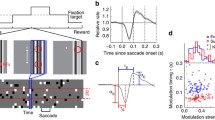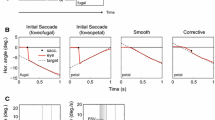Summary
Monkeys were trained to fixate a small spot of light (fixation spot) and to saccade to a peripheral target if and only if the fixation spot was turned off. If the offset of the fixation spot preceded the onset of the peripheral target by a temporal gap of more than 140 ms the animals could change their direction of gaze after saccadic reaction times of no more than 70–80 ms (express-saccades). The reaction times of the express-saccades depend on the luminance and the size of the target and decrease from about 120 ms for near threshold targets by about 50 ms in a range of 2,5 log units above threshold (gap duration 200 ms). The minimum reaction time and the target size for which the minimum is reached are functions of the retinal eccentricity of the target. Comparison with response latencies of afferent visual neurons suggests that the dependence of the reaction times of express-as well as regular-saccades on the physical parameters of the target is mostly determined by retinal factors. The short reaction times of the express-saccades are discussed in relation to the reaction times of other visually-guided goal-directed movements.
Similar content being viewed by others
References
Bach M, Bouis D, Fischer B (1983) An accurate and linear infrared oculometer. J Neurosci Methods 9: 9–14
Becker W (1972) The control of eye movements in the saccadic system. Bibl Ophthalmol 82: 233–243
Bender B (1980) Brain control of conjugate horizontal and vertical eye movements. Brain 103: 23–69
Biguer B, Jeannerod M, Prablanc C (1982) The coordination of eye, head, and arm movements during reaching at a single visual target. Exp Brain Res 46: 301–304
Boch R, Fischer B (1983) Saccadic reaction times and activation of prelunate cortex: Parallel observations in trained rhesus monkeys. Exp Brain Res 50: 201–210
Bolz J, Rosner G, Wässle H (1982) Response latency of brisk-sustained (X) and brisk-transient (Y) cells in the cat retina. J Physiol (Lond) 328: 171–190
Buschnell MC, Goldberg ME (1979) The monkey frontal eye fields have a neuronal signal that precedes visually guided saccades. Neuroscience (Abstract) 5: 2613
Fischer B, Boch R (1981a) Selection of visual targets activates prelunate cortical cells in trained rhesus monkeys. Exp Brain Res 41: 431–433
Fischer B, Boch R (1981b) Enhanced activation of neurons in prelunate cortex before visually guided saccades of trained rhesus monkeys. Exp Brain Res 44: 129–137
Fischer B, Boch R (1983) Saccadic eye movements after extremely short reaction times in the monkey. Brain Res 260: 21–26
Frost D, Pöppel E (1976) Different programming modes of human saccadic eye movements as a function of stimulus eccentricity: Indications of a functional subdivision of the visual field. Biol Cybern 23: 39–48
Goldberg ME, Buschnell MC (1981) Behavioral enhancement of visual responses in monkey cerebral cortex. II. Modulation in frontal eye fields specifically related to saccades. J Neurophysiol 46: 773–787
Hubel DH, Wiesel TN (1968) Receptive fields and functional architecture of monkey striate cortex. J Physiol (Lond) 195: 215–243
Mays LE, Sparks DL (1980) Dissociation of visual and saccade-related responses in superior colliculus neurons. J Neurophysiol 43: 207–232
Mohler CW, Wurtz RH (1977) Role of striate cortex and superior colliculus in visual guidance of saccadic eye movements in monkeys. J Neurophysiol 40: 74–94
Robinson DA (1972) Eye movements evoked by collicular stimulation in the alert monkey. Vision Res 12: 1795–1808
Robinson DA, Fuchs AF (1969) Eye movements evoked by stimulation of frontal eye fields. J Neurophysiol 32: 637–648
Robinson DL, Goldberg ME, Stanton GB (1978) Parietal association cortex in the primate: Sensory mechanisms and behavioral modulations. J Neurophysiol 41: 910–932
Ross LE, Ross SM (1980) Saccade latency and warning signals: stimulus onset, offset, and change as warning events. Percept Psychophys 27: 251–257
Saslow MG (1967) Effects of components of displacement-step stimuli upon latency of saccadic eye movements. J Opt Soc Am 57: 1024–1029
Schiller PH (1977) The effect of superior colliculus ablation on saccades elicited by cortical stimulation. Brain Res 122: 154–156
Schiller PH, Stryker M (1972) Single-unit recording and stimulation in superior colliculus of the alert monkey. J Neurophysiol 35: 915–924
Shibutani H, Sakata H, Hyvärinen J (1983) Saccade and blinking evoked by microstimulation of posterior parietal association cortex of the monkey. Exp Brain Res (in press)
Wagman IH, Krieger HP, Bender MB (1958) Eye movements elicited by surface and depth stimulation of the occipital lobe of macaque mulatta. J Comp Neurol 109: 169–194
Walker AE, Weaver TA (1940) Ocular movements from the occipital lobe in the monkey. J Neurophysiol 3: 353–357
Wurtz RH, Albano JE (1980) Visual-motor function of the primate superior colliculus. Ann Rev Neurosci 3: 189–226
Wurtz RH, Mohler CW (1976) Enhancement of visual responses in monkey striate cortex and frontal eye fields. J Neurophysiol 39; 766–772
Zambarbieri D, Schmid R, Magenes G, Prablanc C (1982) Saccadic responses evoked by presentation of visual and auditory targets. Exp Brain Res 47: 417–427
Zangemeister WH, Stark L (1982) Gaze latency: Variable interactions of head and eye latency. Exp Neurol 75: 389–406
Author information
Authors and Affiliations
Rights and permissions
About this article
Cite this article
Boch, R., Fischer, B. & Ramsperger, E. Express-saccades of the monkey: Reaction times versus intensity, size, duration, and eccentricity of their targets. Exp Brain Res 55, 223–231 (1984). https://doi.org/10.1007/BF00237273
Received:
Issue Date:
DOI: https://doi.org/10.1007/BF00237273




